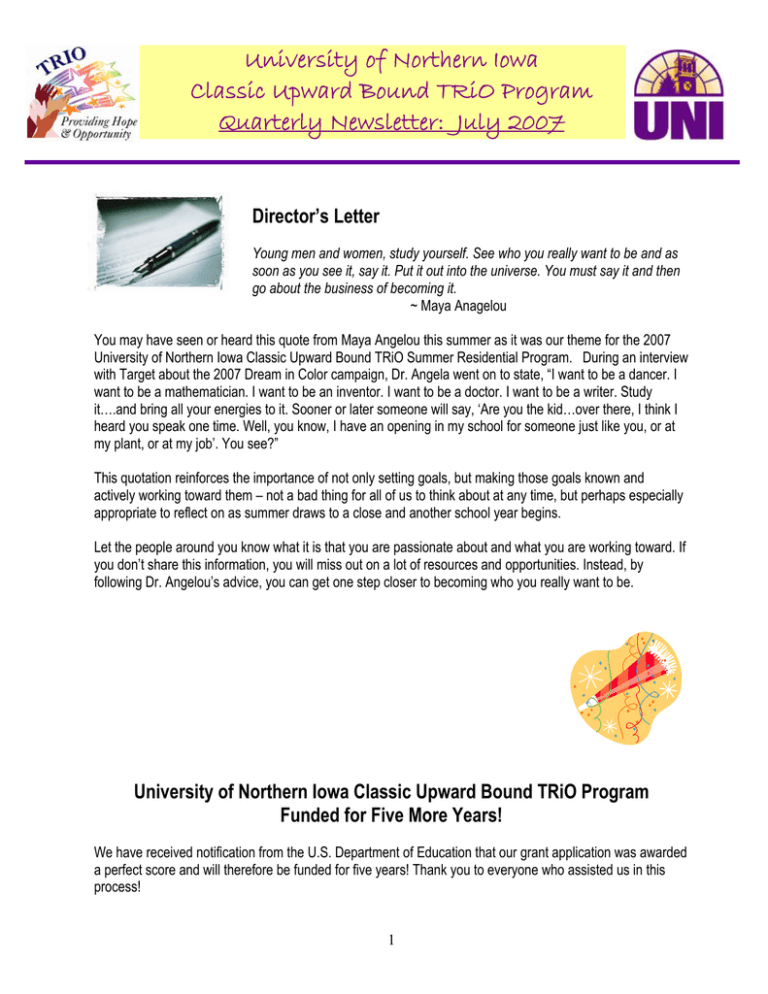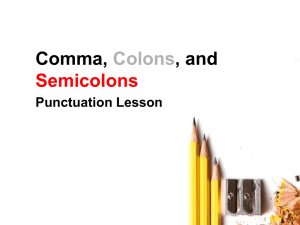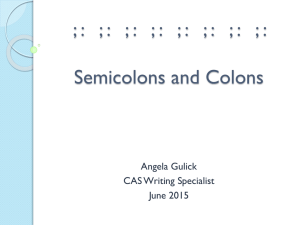University of Northern Iowa Classic Upward Bound TRiO Program Director’s Letter
advertisement

University of Northern Iowa Classic Upward Bound TRiO Program Quarterly Newsletter: July 2007 Director’s Letter Young men and women, study yourself. See who you really want to be and as soon as you see it, say it. Put it out into the universe. You must say it and then go about the business of becoming it. ~ Maya Anagelou You may have seen or heard this quote from Maya Angelou this summer as it was our theme for the 2007 University of Northern Iowa Classic Upward Bound TRiO Summer Residential Program. During an interview with Target about the 2007 Dream in Color campaign, Dr. Angela went on to state, “I want to be a dancer. I want to be a mathematician. I want to be an inventor. I want to be a doctor. I want to be a writer. Study it….and bring all your energies to it. Sooner or later someone will say, ‘Are you the kid…over there, I think I heard you speak one time. Well, you know, I have an opening in my school for someone just like you, or at my plant, or at my job’. You see?” This quotation reinforces the importance of not only setting goals, but making those goals known and actively working toward them – not a bad thing for all of us to think about at any time, but perhaps especially appropriate to reflect on as summer draws to a close and another school year begins. Let the people around you know what it is that you are passionate about and what you are working toward. If you don’t share this information, you will miss out on a lot of resources and opportunities. Instead, by following Dr. Angelou’s advice, you can get one step closer to becoming who you really want to be. University of Northern Iowa Classic Upward Bound TRiO Program Funded for Five More Years! We have received notification from the U.S. Department of Education that our grant application was awarded a perfect score and will therefore be funded for five years! Thank you to everyone who assisted us in this process! 1 Words of Wisdom The great aim of education is not knowledge, but action. ~ Herbert Spencer You've got to do your own growing, no matter how tall your grandfather was. ~ Irish Proverb Eighty percent of success is showing up. ~ Woody Allen July 2 2 3 3 4 13 24 25 26 26 Kate Kalahar Shaudae Moore Alexsis Montover Dominique Western Makayla McDonald Marisa Vivians Andres Martinez Trayvis Redd Tara Taylor Aaron Watley August 4 13 14 20 23 23 25 Jerome Dale Terrence Roberts Jasmine McGee Makiesha Jones Leana Hitchcock Anora Jackson Samantha Foley 2 September 27 Trenton Smith College/University Profile Our newsletter will now be featuring a variety of colleges and universities in each issue to assist you in learning about more institutions. In the last edition, we profiled three private colleges in Iowa - Grand View College, Luther College, and Wartburg College. In this edition, we’ll profile three community colleges in Iowa – Kirkwood Community College, North Iowa Area Community College (NIACC), and Des Moines Area Community College (DMACC): Kirkwood Community College o Public two-year community college o Commuter campus in small city of Cedar Rapids o Off-campus sites in Iowa City, Vinton, Tipton, Williamsburg, Monticello, Washington, Belle Plaine, Marion, and Cedar Rapids. o 14,700 degree-seeking undergraduates o Open admission, but selective for some programs. o ACT/COMPASS test used for placement decisions. o Interview required of vocational-technical, career option applicants. o 2005-2006 Annual Costs: Tuition/Fees - $2,850 o Contact Information: info@kirkwood.cc.ia.us, 1-800-332-2055 ext. 5517 NIACC o o o o o o o Public two-year community college Commuter campus in large town of Mason City 2,515 degree-seeking undergraduates: 56% women, 11% live on campus Open admission, but selective for some programs. Special admission requirements for nursing and physical therapist assistants. 2005-2006 Annual Costs: Tuition/Fees - $3,138; Room/Board - $3,920 Contact Information: request@niacc.cc.ia.us, 1-888-466-4222 ext. 4245 DMACC o Public two-year community college o Commuter campus in large town of Ankeny o Multi-location institution with campuses in Boone, Des Moines, West Des Moines, Carroll, and Newton. Ankeny is the primary location and administrative center. o 16,046 degree-seeking undergraduates: 56% women, 5% African American, 3% Asian American, 3% Hispanic American, 1% International o Open admission, but selective for some programs. o Special admission requirements for dental hygiene, commercial art, nursing, CAP programs. o 2005-2006 Annual Costs: Tuition/Fees - $2,850 o Most Popular Majors: Liberal Arts, Health Sciences, Business/Marketing, Trade and Industry. o Contact Information: 1-800-362-2127 ext. 6241 Source: 2007 College Handbook. The College Board: New York, 2006. 3 The Importance of Writing Skills – Now and in Your Future, Part Five “The pen is mightier than the sword.” -Edward Bulwer-Lytton In this series, we have been stressing the importance of writing skills. They are one of the most essential abilities for students, but are often also one of the most lacking. With that in mind, what follows is information on another common question in writing – how to use SEMICOLONS and COLONS. Semicolons do lots of things. At times, they can act like periods. At other times, they can act like commas. The rules for semicolons are as follows: o Semicolons can separate independent clauses without the help of coordinating conjunctions. o Semicolons can separate items in a list when these items have commas in them. Here are a few examples of these rules in practice: Common Mistake: Correction: Her strategy was to eat healthy; and she knew it would work. Her strategy was to eat healthy; she knew it would work. Common Mistake: Her plan was to eat a healthy variety of food, including grains, half of them whole grains, vegetables, fresh and in season, and fruits, fresh and in season. Her plan was to eat a healthy variety of food, including grains, half of them whole grains; vegetables , fresh and in season; and fruits, fresh and in season. Correction: Colons introduce lists and explanations. The rules for colons are as follows: o Colons can be used before a list when the list is introduced by a complete sentence. o Colons can introduce and explanation. Here are a few examples of these rules in practice: Common Mistake: Correction: Watch out for high-sugar foods, ice cream, candy, and cookies. Watch out for high-sugar foods: ice cream, candy, and cookies. Common Mistake: Correction: Don’t believe all you see, fast-food ads can be deceiving. Don’t believe all you see: fast-food ads can be deceiving For Practice: Change the punctuation or words so that semicolons and colons are used correctly in the following sentences: 1) Alex varied his vegetables every week; so he chose some red, some green, and some orange. 2) Make these choices fat-free or low-fat, milk, yogurt, and cheese. 3) For health benefits, eat a variety of food, grains, for carbohydrates, vegetables, for fiber, fruit, for vitamin C, dairy, for calcium, and meat and beans, for protein. 4) Less is more, limit fats, cholesterol, salt, and added sugars. Here are the same sentences written correctly: 1) Alex varied his vegetables every week; he chose some red, some green, and some orange. 2) Make these choices fat-free or low-fat: milk, yogurt, and cheese. 3) For health benefits, eat a variety of food: grains, for carbohydrates; vegetables, for fiber; fruit, for vitamin C; dairy, for calcium; and meat and beans, for protein. 4) Less is more: limit fats, cholesterol, salt, and added sugars. Source: “Getting Your Writing Right: Skills to Help You Avoid Common Writing Mistakes.” South Deerfield, MA: Channing Bete Company, 2006. 4 What careers would interest me? One way of determining careers that would be of interest to you is to think about what academic subject areas you like and do well in. Consider careers in the following areas: English Actor/actress Advertising manager Broadcaster Court reporter Editor Journalist Lawyer Librarian Minister Paralegal Public relations specialist Receptionist Reporter Secretary Speech pathologist Teacher/professor Technical writer Writer/author Fine Arts Actor/actress Advertising manager Architect Artist Art therapist Composer Dancer/Choreogra pher Fashion designer Film producer/editor Floral designer Graphic artist Illustrator Interior designer Landscape architect Music therapist Musician Photographer Sound engineer Teacher/professor Foreign Language Flight attendant International business International lawyer Interpreter Linguist Multilingual social worker/nurse Teacher/professor Translator Travel agent Math Accountant Actuary Bank manager/teller Computer programmer Electrician Engineer Financial planner Insurance agent Investment analyst Loan officer Meteorologist Physicist Real estate appraiser Statistician Systems analyst Teacher/professor Tool and die maker Web site developer Science Athletic trainer Biologist Botanist Chemist Chiropractor Dental hygienist Dentist Emergency Medical Technician Engineer Environmentalist Forester/ranger Geologist Medical technician Meteorologist Nurse Nursery worker Nutritionist Optometrist Pharmacist Physician Physicist Physical therapist Speech pathologist Teacher/professor Veterinarian Zoologist Social Studies Anthropologist Archaeologist City manager Clergy Corrections officer Criminologist Economist FBI/CIA agent Geographer Historian Lawyer Lobbyist Newscaster Paralegal Politician Psychologist Social Worker Sociologist Teacher/Professor Urban Planner For more information on any of the above careers, speak to an UNI Upward Bound staff member. Source: “Career Choices and Educational Options.” Dayton, OH: Woodburn Press, 2006. 5



